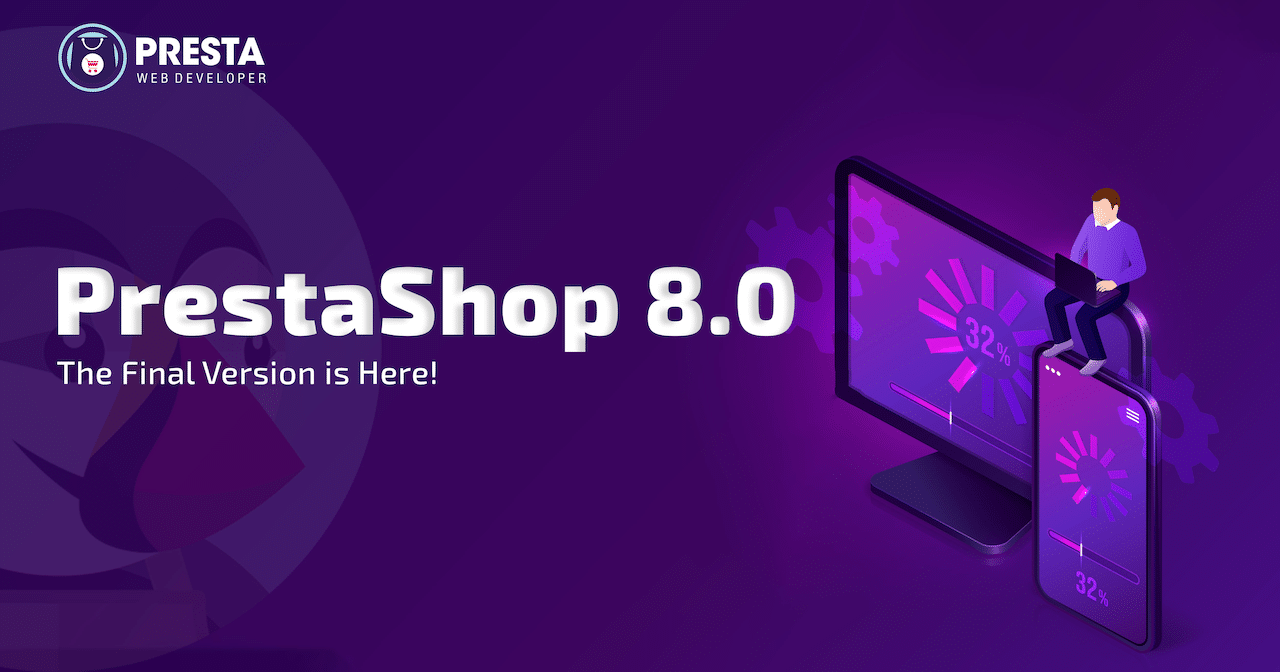You may have already seen it, and some of you may even have adopted it, but PrestaShop version 8.0 has been around since the last quarter of 2022.
The successor to version 1.7 of our favorite CMS, after several months spent in beta and a constantly delayed official launch, is finally out!
So, is it a real e-commerce revolution, compared to the previous version (which dates back to 2016)?
Or is it a simple addition of little interest?
We’ll take a closer look in this article. 
The main changes brought by version 8.0
If Prestashop didn’t simply continue with its digital suite, releasing version 8.0 instead of 1.8, it’s because the changes and new features of this brand-new version were destined to be big.
Significant changes have been made in terms of architecture and code, security, new functionalities and ergonomics.
Version 8.0 compatibility extended to several programming languages
This particular feature of PrestaShop version 8.0, aimed more at developers, enables the cms to integrate PHP 8 and 8.1 development support, as well as Symfony 4.4.
The aim here is to keep the code up to date, thereby accelerating the release of new features.
A reassuring point, without being very innovative, if we consider this new version as a “foundation” designed to easily accommodate future enhancements and additions.
More freedom for PrestaShop sales management
This update to version 8.0 now enables e-tailers to choose their profile type when using the cms: you are given the choice between a supervised commercial management, presenting you with the platform’s tools, addons, themes and modules in an active way.
You’ll be supported in your project, but you’ll also be more likely to receive commercial offers targeted to your needs.
Conversely, you can now choose a much more “open source” cms solution, giving you much greater freedom to build your store, your offers or the modules you do or don’t want to use.
PrestaShop products and services will no longer be offered by default, but will always be available via the PrestaShop Addons Marketplace.
This is an important and welcome option, which will enable all profiles to benefit from a space that matches their needs.
PrestaShop Academy now available
PrestaShop’s training platform (free and paid) can now be accessed directly from the solution.
This is a very useful addition, as it eliminates the need to go back and forth between the back-office and the training platform, while still displaying all the new features (although you can still access the platform via external links such as this one).
Greater security options for your PrestaShop
An essential point of this new version 8.0: the addition of a new security menu, aimed at combating fraud and fake accounts, and offering you, among other things, the possibility of setting your security options, such as password requirement levels.
This menu should be the starting point for future developments in terms of security options.
A new interface for product creation in version 8.0
While PrestaShop does not intend to fundamentally change its interface for product creation, it has nevertheless added a number of new features, notably in the form of new product variation options.
New graphic layouts for product management in the back office have also been created, as well as the possibility of switching appearances in the near future to facilitate and diversify product creation.
The aim here is to make PrestaShop’s product creation interface more permissive and clearer.
While not all the announced changes have yet been implemented on the platform, this new interface is just like version 8.0: fertile ground for the addition of future options and positive changes.
Watch this space closely.
Creation of a new default theme for e-tailers
While the default theme of version 1.7 worked well in terms of ergonomics and diversity for image blocks.
The new default theme for PrestaShop version 8.0 is even more practical and permissive, with a greater variety of locations for images and carousels.
An appreciable improvement, even if it’s in keeping with the “classic” (but still effective) themes offered by PrestaShop.
Theme selection during installation
In version 1.7, the choice of theme and main modules was systematically made after installation, which could cause problems in terms of visualizing the final rendering and the options you wished/could add.
This new possibility of choosing themes and modules before the complete installation avoids the need to go back and forth to the back-office to modify everything once the installation is complete.
This update to PrestaShop version 8.0 saves time and gives you greater control over the final look and feel of your site.
When and how do I migrate to PrestaShop 8.0?
If you’ve recently launched a new project using the PrestaShop cms, you’ve probably already acquired version 8.0.
If, however, you wish to migrate an existing store from version 1.7 to version 8.0, there are several ways to do so.
However, I’d advise you to use the dedicated module directly from the module interface of your back-office, so you can be sure of migrating from one version to another under the best possible conditions and without risking altering the content of your store.
For more information on how to migrate safely from one version to another (and the benefits of doing so), please see my previous article “How to upgrade Prestashop”. Although this new version has been officially out for a few months now, the rule remains the same: observe and wait a little to see how this version reacts on the market (outside beta), just as it’s worth waiting for any bugs to be corrected.
In conclusion: what do you think of PrestaShop version 8.0?
Without being revolutionary, this new version brings its share of essential updates for the future of the cms, namely: enhanced platform security and stability; increased compatibility with the most useful scripting languages on this type of support; a solid foundation for the release of new functionalities; and an emphasis on ergonomics and clarity that is sure to delight newcomers.
Admittedly, the changes to your e-commerce store won’t be obvious.
But all in all, what we have here is a slightly more powerful, ergonomic and faster version of PrestaShop, with the possibility of running several websites on a single VPS without any problems.
The graphical overhaul of product pages and the early selection of themes and modules are also major highlights of this version.
It remains to be seen whether the promises of new features and stability over time will be kept.
As an e-commerce expert and PrestaShop specialist, I can help you build or migrate your e-commerce site to version 8.0.
Don’t hesitate to contact me if you have any questions about migration or store optimization!


